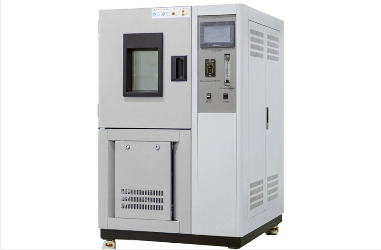Time: Popularity:0times
Accelerated aging chambers are essential tools for evaluating how materials perform over time under different environmental conditions. By simulating factors like light, heat, humidity, and corrosive exposure, these chambers allow manufacturers, researchers, and testing laboratories to quickly assess durability, stability, and long-term performance without waiting for years of real-world exposure.

They are widely used in industries such as plastics, coatings, rubber, electronics, automotive, and construction materials. Choosing the right chamber depends on the material, environmental factors to simulate, and relevant standards.
UV accelerated aging chambers use UV fluorescent lamps to replicate sunlight while controlling temperature and moisture. They are ideal for assessing how plastics, coatings, rubber, and textiles react to long-term UV exposure.
Key Features:
UV-A/UV-B fluorescent lamps
Precise temperature control
Condensation or water spray cycles
Automated data monitoring
Applications: Plastics, coatings, rubber, textiles, automotive parts
Standards: ASTM G154, ASTM D4329, ISO 4892, GB/T 16422
Advantages:
Simple operation and relatively low cost
Energy-efficient and easy to maintain
Provides fast preliminary UV resistance evaluation
Limitations:
UV spectrum is narrower than natural sunlight
Less effective for materials sensitive to long-wave UV
Accelerated results may differ slightly from actual outdoor conditions
Xenon chambers use full-spectrum xenon arc lamps to closely simulate natural sunlight, including UV, visible, and infrared light. They are widely used when accurate outdoor simulation is critical, such as for automotive coatings and outdoor plastics.
Key Features:
Full-spectrum light simulation (UV, visible, IR)
Temperature and humidity control
Water spray or condensation cycles
Programmable test cycles
Applications: Automotive coatings, outdoor plastics, paints, textiles, solar panels
Standards: ASTM G155, ISO 11341, ISO 4892-2, GB/T 16422
Advantages:
Closely replicates natural sunlight
Tests multiple light effects simultaneously
Ideal for high-precision durability studies
Limitations:
Higher equipment cost
Maintenance-intensive, with lamp replacements required
Relatively high energy consumption
High-temperature aging chambers evaluate how materials respond to elevated temperatures over time. They are particularly useful for plastics, rubber, electronics, and adhesives.
Key Features:
Adjustable temperature up to 200–300°C
Uniform heat distribution through forced air circulation
Standards: ASTM D3045, ISO 188, GB/T 1690
Advantages:
Rapid evaluation of thermal degradation
Simple design and easy operation
High temperature accuracy
Limitations:
Cannot simulate humidity or light exposure
Extreme temperatures may cause non-natural material degradation
These chambers allow precise simulation of high humidity and temperature, making them ideal for electronics, coatings, plastics, paper, and textiles.
Key Features:
Relative humidity adjustable from 20–98%
Accurate temperature control
Stable long-term operation
Standards: IEC 60068-2-78, ASTM D2247, ISO 6270, GB/T 10592
Advantages:
Precise and stable control
Suitable for long-term testing
Limitations:
No light exposure simulation
High humidity may accelerate corrosion or mold growth, requiring careful maintenance
Combined chambers simulate multiple environmental factors at once, such as light, heat, and humidity, closely mimicking real-world conditions.
Applications: Automotive and aerospace components, electronics, solar panels, outdoor equipment
Standards: ISO 4892, IEC 60068 series, ASTM D4587
Advantages:
Provides a realistic, integrated simulation
Suitable for high-demand and composite materials
Reliable and comprehensive test data
Limitations:
Complex and costly
Requires careful operation and maintenance
Needs significant laboratory space
Salt spray chambers test metal and coating resistance to corrosion, a critical factor for automotive, electronics, and hardware applications.
Key Features:
Salt fog or mist exposure
Controlled temperature and monitoring of pH and solution concentration
Standards: ASTM B117, ISO 9227, GB/T 10125
Advantages:
Rapid corrosion evaluation
Simple operation and monitoring
Widely used across metal and coating industries
Limitations:
Does not simulate UV or thermal aging
Limited use for non-metal materials
Thermal shock chambers evaluate how materials respond to rapid temperature changes, helping identify potential failures under extreme conditions.
Applications: Electronics, semiconductors, automotive components, ceramics, plastics
Standards: IEC 60068-2-14, MIL-STD-810, GB/T 2423.1/2
Advantages:
Simulates real-world thermal stress
Fast detection of material tolerance
Applicable to a wide range of components
Limitations:
Only tests thermal shock, not UV or humidity
Requires careful handling and operation
Q1: How do I choose the right accelerated aging chamber?
Consider material type, environmental factors to simulate, and relevant standards. For multi-factor testing, a combined environment chamber is recommended.
Q2: What’s the difference between UV and xenon chambers?
UV fluorescent chambers are cost-effective and suitable for rapid UV testing.
Xenon chambers provide a more accurate sunlight simulation for high-precision durability studies but are more expensive.
Q3: Can accelerated aging completely replace outdoor exposure?
Not entirely. Accelerated testing provides trends and predictive data, but outdoor exposure remains important for final validation.
Q4: What maintenance is required?
Check lamp life regularly, clean sensors and chamber, calibrate temperature, humidity, and irradiance.
Replace lamps according to standards to ensure accuracy.
Q5: Can the chambers be customized?
Yes. Temperature, humidity, light type, chamber size, and cycle programs can all be customized for specific testing or certification needs.
At our company, we are professional manufacturers and solution providers for accelerated aging and testing instruments. We provide:
Full-service solutions: From R&D and manufacturing to sales and after-sales support
Customizable instruments and test programs: Tailored to client requirements
Expert technical support: Helping optimize testing and improve material quality control
Our instruments are designed to deliver reliable, repeatable results, helping clients predict material performance, reduce product failures, and accelerate development.
Company Phone
+86-21-6420 0566
Working hours
Monday to Friday
Mobile phone:
13816217984
Email:
info@qinsun-lab.com
